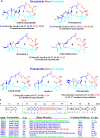Biosynthesis of HSAF, a tetramic acid-containing macrolactam from Lysobacter enzymogenes
- PMID: 21171605
- PMCID: PMC3078565
- DOI: 10.1021/ja105732c
Biosynthesis of HSAF, a tetramic acid-containing macrolactam from Lysobacter enzymogenes
Abstract
HSAF was isolated from Lysobacter enzymogenes , a bacterium used in the biological control of fungal diseases of plants. Structurally, it is a tetramic acid-containing macrolactam fused to a tricyclic system. HSAF exhibits a novel mode of action by disrupting sphingolipids important to the polarized growth of filamentous fungi. Here we describe the HSAF biosynthetic gene cluster, which contains only a single-module polyketide synthase/nonribosomal peptide synthetase (PKS/NRPS), although the biosynthesis of HSAF apparently requires two separate polyketide chains that are linked together by one amino acid (ornithine) via two amide bonds. Flanking the PKS/NRPS are six genes that encoding a cascade of four tightly clustered redox enzymes on one side and a sterol desaturase/fatty acid hydroxylase and a ferredoxin reductase on the other side. The genetic data demonstrate that the four redox genes, in addition to the PKS/NRPS gene and the sterol desaturase/fatty acid hydroxylase gene, are required for HSAF production. The biochemical data show that the adenylation domain of the NRPS specifically activates L-ornithine and that the four-domain NRPS is able to catalyze the formation of a tetramic acid-containing product from acyl-S-ACP and ornithinyl-S-NRPS. These results reveal a previously unrecognized biosynthetic mechanism for hybrid PK/NRP in prokaryotic organisms.
Figures



References
Publication types
MeSH terms
Substances
Grants and funding
LinkOut - more resources
Full Text Sources
Other Literature Sources
Miscellaneous

